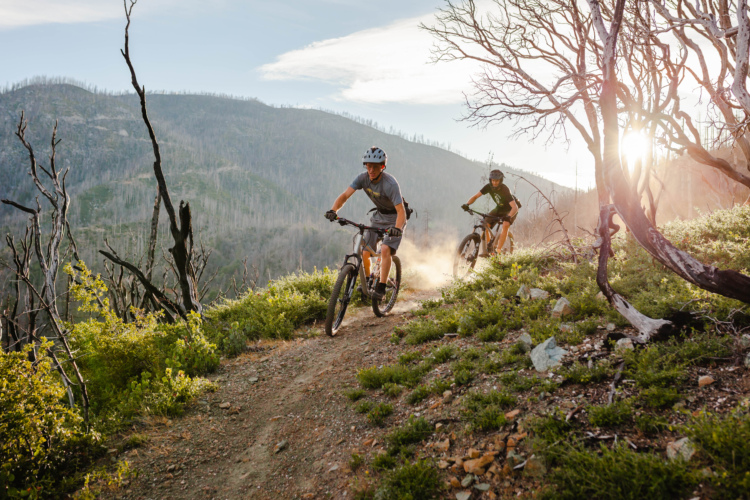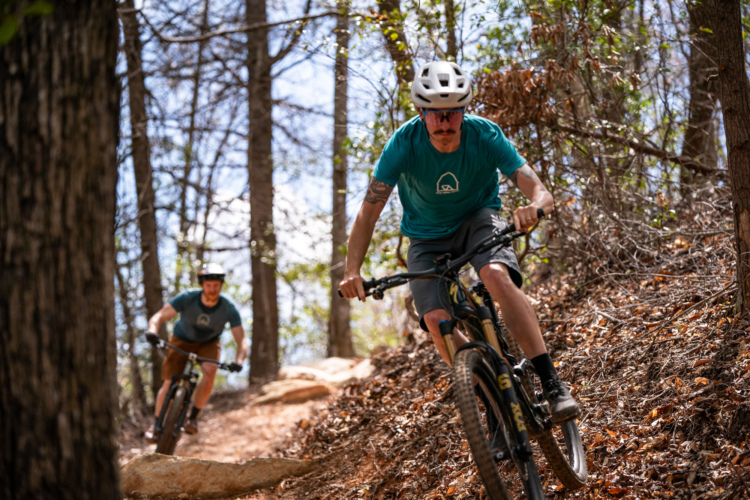
Santa Cruz Megatower V2
- Price: $9,800 as tested. Additional builds priced from $5,649 to $14,000.
- Buy from Jenson USA
Santa Cruz has been on a roll this year, updating their long-travel Megatower, the mid-travel Hightower, and most recently the 27.5″ shred-sled Nomad, which went to a mixed-wheel platform. The Megatower V2 is still a fairly new rig for Santa Cruz. The first generation debuted just three years ago competing with the likes of the Yeti SB150 and the Pivot Firebird.
What is the difference between Megatower V1 and V2?
Travel
First, the bike gained 5mm of rear travel and 10mm of fork travel. That travel has been revised too with a lower overall leverage rate, which Santa Cruz said should give more support for aggressive riding and better bottom-out resistance.
Geometry
The geometry gets some changes as well. The reach grew slightly; about 5mm on a medium in the low position and the head tube angle dropped by 1.2° to 63.5° in the low position. The chainstays are just a millimeter or two longer depending on the position and the seat tube angle steepened by 1.2° as well, to 77.2° in low.
Perhaps the biggest change geometrically is the wheelbase. Santa Cruz added over an inch of length to the bike. While the other measurements don’t reflect a sweeping overhaul, the Megatower V2 reasonably seeks more stability through its overall length. The previous generation of the Megatower had a rather conservative wheelbase length at 1,208mm (medium), though the times keep changing.
The Megatower V2 now has size-specific chainstays too but the flip-chip at the axle is gone. There is still a flip-chip where the shock meets the lower link, but as you can see in the geo chart, the change is pretty negligible with a third of a degree in the head tube angle.
Storage
Other touches on the new rig include a wider down tube — be prepared for the “whoa, is that an e-bike?” comments. The wider down tube opens up storage space for Santa Cruz’s answer to the Specialized SWAT Box, the Glovebox. It’s a pretty sweet way to pack all your everyday carry items like a tube and tools.
Price
There’s one other area of the Megatower V2 that’s grown and that’s the MSRP. The first-gen Megatower frameset sold for $3,300 and base models started at $4,500 and topped out at $10,500.
The latest Megatower frame sets sell for almost a thousand dollars more at $4,249 and base models start at $5,649. The top-end build (drum roll please): $14,000 and if you’ll refer to my above sentence again, no this isn’t an e-bike. To be fair, SRAM Flight Attendant adds a lot of cost to the top build.
Our electronic drivetrain-equipped GX AXS RSV build with the C carbon frame retails for $9,800. This includes a SRAM GX AXS drivetrain, a RockShox SuperDeluxe Select+ shock, Fox 38 Performance Elite fork with Grip2 damper, SRAM Code RS brakes, and Reserve 30 rims with Industry Nine 1/1 hubs.

Climbing on the Santa Cruz Megatower
It’s been a while since I rode the first generation Megatower. I rode it shortly after the release in the spring of 2019 at a Sea Otter event, and I remember thinking (and writing) the Megatower felt lively, poppy, and was an admirable all-arounder for being a 160mm bike. With the newest generation, Santa Cruz steered the bike into all-out enduro territory.
My first weekend aboard the new Megatower, I took it to Breckenridge where the air is thin and the climbs are steep. Bikes quickly reveal their ascending prowess and it was an excellent weekend to get acquainted with the bike.
Initially I scoffed at the 30T chainring since it had SRAM’s 52T granny gear on the back but my skepticism was short-lived. On moderate, flatter terrain the Megatower spins along quite well, but the pros and cons of the bike come alive when the ups get tough.

Pros: the reduced anti-squat gives the bike loads of traction and you’ll have a tough time breaking the tire from the ground.
Cons: reduced anti-squat makes the rear suspension much more active and it’s not the most efficient-feeling platform for sustained efforts up hill. i.e.: you have to work harder. Sometimes this meant that I lost steam more quickly than on other bikes up steep climbs.
With a similar change in seat tube angle and head tube angle the seating position doesn’t feel notably steep. On some pitches, I’d have to scoot up to the nose of the saddle to get my weight more forward.
The Megatower isn’t going to reward you much for sprinting out of the saddle either. All in all, aside from incredible traction on choppy climbs, there’s nothing that really makes the Megatower stand out on the way up to get down.

Descending performance
Not too firm, not too soft. Just right. We’re talking about bikes here, right? Compared to some other rigs out there, the suspension on the Santa Cruz Megatower V2 feels a little soft climbing, but there are tradeoffs to everything and let’s remember this is a 165mm enduro bike.
The Megatower V2 picks up speed quickly on the descent and the VPP soaks up trail chatter like a sponge to water. The VPP’s performance is part of what makes the bike feel so great on the downs. The suspension is very active through small and medium bumps but with plenty of support when you carve through a berm or come off a drop.
While the first Megatower felt more lively, the latest iteration is mindful of how to keep a rider’s confidence high when things get steep and loose. I would hesitate to describe it as playful, although it can be at times. The Megatower V2 likes speed and that comes with excellent tracking through rocks and dusty chunder. At 438mm, the chainstay isn’t the shortest out there, but I didn’t notice wagging it like a dog’s tail around rollers and switchbacks. Just because a bike likes to go fast doesn’t mean it isn’t playful; confidence equals fun.
The Santa Cruz Megatower V2 just isn’t one of those bikes that wants to bound off of side hits and kickers, but that’s ok. It does feel well-composed off drops, unnerved and ready for more.

Santa Cruz Megatower V2 component check
For the most part, the build kit on the GX AXS RSV model was great, but at almost $10,000 it better be. Bike and supply shortage, pandemic, and inflation aside, the Megatower has gotten downright expensive and I don’t think it would hurt to introduce aluminum models. The difference in frameset prices alone is about 30% compared to the previous gen. While I liked the build kit (for the most part), it’s disappointing that the model I tested doesn’t feature their most premium CC frame. The GX AXS RSV build is still almost 34lb heavy too.

Dropper Post
If there’s one glaring area of improvement though, it’s the dropper post. Not only was the 150mm on my medium test rig too short and mildly annoying on descents, the RockShox Reverb started to get mushy shortly after I received the bike. It’s not the most convenient fix either, considering you have to remove the saddle to access the vent valve on top of the post and use a special tool from RockShox to get air out of the system. I had to do this a few times during my test period too. Santa Cruz said in this case, the buyer would want to work with the shop they bought it from or directly with SRAM.
Brakes
I’m still not totally sure how I feel about the Code RS brakes either. Likely, they could be topped off with brake fluid for a sharper bite, but I had a lot of dead space in my throw before the pads gripped the rotors. The Codes do have a nice bite when they do make contact though and were appropriately matched with 200mm rotors for good stopping power.
Wheels
The Reserve 30s actually got a lot of comments though and they felt like a great wheel and helped the bike shine. They didn’t feel harsh once but were still stiff enough to cleanly transfer power.

Glovebox
Lastly, I can’t say I used the Glovebox much, but I probably would if I owned the bike. I can see where the feature would come in handy by always having a tool and tube in there rather than trying to track down your hip pack every time for a ride. There’s a surprising amount of room and it should fit most essentials.

Pros and cons of the Santa Cruz Megatower V2
Pros
- Traction and confidence on descents
- Trunk space
- Size-specific frame layup and chainstays
Cons
- Expensive
- Can be a dog on climbs
Closing thoughts
The latest generation Santa Cruz Megatower’s ambitions aren’t ambiguous. It’s a long-travel 29er meant for cooking with fire downhill. That comes with some sacrifices. It’s not all that light and even though the geometry makes climbing more pleasant, it’s not a snappy climber either. For riders who know what they want out of a bike — screaming confidence down the roughest trails — the Megatower delivers.
- Price: $9,800 as tested. Additional builds priced from $5,649 to $14,000.
- Buy from Jenson USA






















2 Comments
Aug 30, 2022
Aug 30, 2022